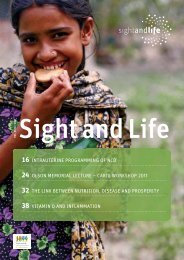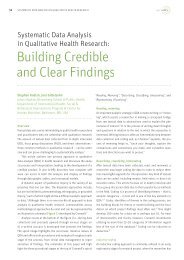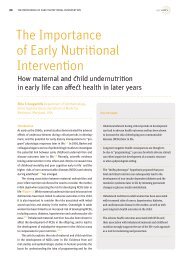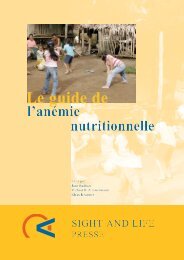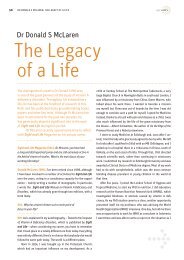Sight and Life Magazine 1/2011
Sight and Life Magazine 1/2011
Sight and Life Magazine 1/2011
You also want an ePaper? Increase the reach of your titles
YUMPU automatically turns print PDFs into web optimized ePapers that Google loves.
SIGHT AND LIFE | VOL. 25 (1) | <strong>2011</strong> NEW DEVELOPMENTS IN CAROTENOIDS RESEARCH 6969expert key messages-caroteneLuteinZeaxanthinLycopeneis a safe source of vitamin A. Its pro-vitamin A function is a crucial contribution to the required totalvitamin A intake in both developed <strong>and</strong> developing countries. Vitamin A is essential for normal growth <strong>and</strong>development, the immune system, vision <strong>and</strong> other functions in the human body. The intake of preformedvitamin A from animal products is not sufficient in major parts of the population all over the world, includingEurope, the US <strong>and</strong> Asia. Recent studies suggest that suboptimal levels of vitamin A <strong>and</strong> -carotene, evenlevels well above those causing clinical defi ciency syndromes, can be a contributing risk factor in chronicdiseases. An appropriate intake of -carotene in diets, forti fied foods <strong>and</strong>/or dietary supplements couldsafely compensate for the lack of vitamin A.is a natural pigment <strong>and</strong> potent antioxidant present in the macula of the eye <strong>and</strong> in the skin. It acts as afilter, shielding against the damaging near-to-UV blue light of the sun. Higher dietary intake of foods rich inlutein <strong>and</strong> zeaxanthin is being discussed for its potentially positive, preventive effects on macular degeneration<strong>and</strong> cataracts, as well as improved visual performance. Based on a wealth of scienti fic literature, luteinis considered an eye health nutrient, supporting healthy eyes <strong>and</strong> vision as people age.is, in addition to lutein, the only other major carotenoid specifically located in the macula of the eye.Zeaxanthin, found in the retina, also protects the eye from damage caused by the near-to-UV blue light of thesun. Higher dietary intake of foods rich in lutein <strong>and</strong> zeaxanthin has been associated with a reduced risk ofmacular degeneration <strong>and</strong> cataracts.is one of the strongest antioxidants among the carotenoids. Scientifi c evidence suggests that lycopene helpsprotect cells against oxidative damage, <strong>and</strong> it is discussed <strong>and</strong> researched in the scienti fic community for itsbenefi ts to cardiovascular health.intake, <strong>and</strong> that the provitamin A function of -carotene is essentialto achieve vitamin A intake recommendations in bothdeveloped <strong>and</strong> developing countries.Summarizing the results of epidemiological <strong>and</strong> human supplementationstudies with -carotene in chronic disease prevention,Susan T Mayne (Yale Schools of Public Health <strong>and</strong> Medicine,USA) concluded that intervening in populations with low-carotene status in order to improve it may be a more promisingapproach than intervening in populations with adequatestatus in order to raise it to a “supra” adequate status. However,this more personalized approach to nutrient-based interventionis critically dependent on the availability of biological markersof status – in this case, carotenoid status. Recent advances inthe development of promising new methods for rapidly <strong>and</strong> noninvasivelyassessing carotenoid status suggest that it is increasinglyfeasible to identify the persons most likely to benefit fromcarotenoid interventions, allowing for future intervention trialswith a greater likelihood of demonstrating beneficial effects thanseen to date.L<strong>and</strong>mark findingsFrancine Grodstein (Harvard Medical School, USA) reported onclinical studies evaluating the effect of antioxidant -carotenesupplements on cognitive decline in older persons. Most notably,in the Physicians’ Health Study II 6,000 older men were r<strong>and</strong>omizedto 50 mg of -carotene supplementation on alternatedays, ranging from one to up to 18 years. For participants withlong-term supplementation, cognitive function was significantlybetter compared to long-term placebo. Other research in thisarea has been inconsistent with these l<strong>and</strong>mark findings. Theexplanation for these discrepant findings is not clear, although itis possible that some combination of the appropriate dose <strong>and</strong>







